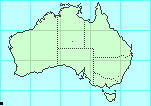
Common Name:
Delete this section if there is no common name.
Identification:
Length: 146mm.
Coloring:
Note any distinguishing features.
male volant and mesopterous, female flightless and mesopterous
 Note parental placement of eggs.
Note appearance of eggs.
Note any common variations.
Note parental placement of eggs.
Note appearance of eggs.
Note any common variations.
Habitat:
Note if the species arborial or terrestrial.
Canopy, mid, under, etc.
Note typical vegetation, e.g.
tropical rainforest, temperate rainforest,
grasslands,
alpine, etc.
Similar Species:
Ctenomorphodes tessulata
Rearing Notes:
Note if this species has ever been reared.
Note any suggestions for successful rearing.
PSG notes indicate the following foodplants have been used successfully
in captivity: Bramble, Oak, Eucalyptus.
For a stick insect with body length 146mm, to keep 2 adult females,
you need a cage at least 650mm high, 300mm deep and 300mm wide.
 Range:
Range:
NE coastal, QLD
Status:
It is not known if this species is endangered,
as there is insufficient sighting history.
References
-
Balderson, J., Rentz,
D.C.F. and Roach, A.M.E. (1998).
in
Houston, W.K.K. & Wells, A. (1998) (eds)
Zoological Catalogue of Australia.
Vol. 23.
Archaeognatha, Zygentoma, Blattodea, Isoptera, Mantodea, Dermaptera,
Phasmatodea, Embioptera, Zoraptera.
Melbourne: CSIRO Publishing, Australia (ISBN 0643 06035 9).
pp. 347 - 376.
-
Clark, J.T. (1976).
The eggs of stick insects (Phasmida): a review with
descriptions of the eggs of eleven species.
Syst. Ent. 1: 95-105.
-
Gray, G.R. (1834).
Descriptions of several species of Australian Phasmata.
Transactions of the Royal Entomological Society of London,
i, 1 (November 7), pp. 45-46.
-
Gray, G.R. (1835).
‘Synopsis of the Species of Insects Belonging to
the Family of Phasmidae.’ 48pp.
(Longman, Rees, Orme, Brown, Green and Longman: London.)
-
Key, K.H.L. (1957).
Kentromorphic phases in three species of Phasmatodea.
Australian Journal of Zoology 5: 247-284
-
Rainbow, W.J. (1897).
Catalogue of the described Phasmidae of Australia.
Records of the Australian Museum, 3(2), 37-44.
[Note that he made a mistake re Extatosoma popa and E. tiaratum
according to
Gurney, A.B. (1947).
Notes on some remarkable Australasian walkingsticks, including a
synopsis of the Genus Extatosoma (Orthoptera: Phasmatidae).
Annals of the Entomological Society of America. 40(3): 373-396.
.]
-
Tepper, J.G.O. (1902).
List of the Described Genera and Species of the Australian and Polynesian
Phasmidæ (Spectre-Insects).
Transactions of the Royal Society of South Australia, 26: 278-287.
-
Vickery, V.R. (1983).
Catalogue of Australian stick insects (Phasmida,
Phasmatodea, Phasmatoptera, or Cheleutoptera). CSIRO
Australian Division of Entomology Technical Paper, No. 20, 15 pp.
- Search Google for
Ctenomorphodes briareus,
or search Google Scholar for
Ctenomorphodes briareus.
Phasmid Study Group
This is PSG species 15.
It is described in PSG Newsletter #7.
Synonyms:
-
Acrophylla briareus Gray, 1835
-
Ctenomorpha nigrovaria Stål, 1875c
-
Ctenomorpha albopunctatum Kirby, 1896
-
Diura briareus Gray, 1834
Copyright © 2000-2003
Peter Miller
This page was last changed 20-Sep-2006.
|

|

|
 Note parental placement of eggs.
Note appearance of eggs.
Note any common variations.
Note parental placement of eggs.
Note appearance of eggs.
Note any common variations.

 Note parental placement of eggs.
Note appearance of eggs.
Note any common variations.
Note parental placement of eggs.
Note appearance of eggs.
Note any common variations.
 Range:
Range: 
